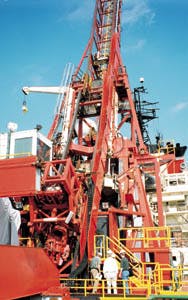Marshall DeLuca
Houston
Coflexip Stena Offshore's MJ Lay system.
Vessel day rates:
how low will they go?
Times are tough, especially for the drilling contractor who feels the direct hit of operators canceling projects and delaying drilling plans, resulting in lower and lower day rates. But, have we seen the bottom of the market? According to the day rates - no. It has been reported that day rates for jackup drilling units in the Gulf of Mexico, eager to get to work at almost any price, dipped below the $10,000/day mark. Rowan reportedly had two shallow water jackups that worked under the $10,000 mark for a 20-day well each. The rigs were then contracted at $18,000/day. Currently, the company's fleet is at 50% utilization, a number which Rowan expects to increase to 80-85% by the second half of this year. While, this may not be the bottom, at rates of under $10,000, we must be close - hopefully.
In deepwater, size does matter
When drilling in over 5,000 ft of water, size is definitely an issue. A vessel must have the capability to transport the necessary materials such as riser and pipe for the drilling operations and subsequently have a massive variable deckload. To achieve this, operators have been turning to the drillship, which offers the high deckload and the mobility needed to drill in such depths. In fact, the three most recent world water depth drilling records were set by drillships: Transocean's Discoverer 534 and Discoverer Seven Seas, and most recently Global Marine's Glomar Explorer.It is this flexibility and proven track record that has resulted in a high operator demand for new drillships. Currently, several vessels are on order and under construction, and most recently the world's largest drillship, Conoco and R&B Falcon's Deepwater Pathfinder, began its first job in the Gulf of Mexico.
The Deepwater Pathfinder measures 726.5 ft long by 137.8 ft wide, far surpassing the world record holder Glomar Explorer, at 619 ft by 115 ft, and previous record-holder Discoverer Seven Seas, at 534 ft by 80 ft. And, in addition three more drillships of Pathfinder proportions are under construction (Deepwater Frontier, Deepwater III, and Deepwater IV), leading to a fleet of drillships of gargantuan size.
However, Transocean will extend this philosophy of "bigger is better" with the long-awaited christening of the Discoverer Enterprise in May. When it sails out of the Ingalls Shipyard in Pascagoula, Mississippi, the Enterprise will far surpass the Pathfinder as the largest. The vessel measures 834.8 ft in length and 124.8 ft in width (108.3 ft longer than the Pathfinder). However, both vessels are rated at the same variable deckload of 20,000 metric tons.
Does this massive size mean that the Enterprise is better in deepwater than the Pathfinder and its predecessors? Not necessarily, Transocean and contracted operator BP-Amoco are putting their hopes in the advanced drilling package on the rig and the state-of-the-art dual activity capabilities as keeping the edge over the competition. However, regardless of the size and capabilities of the Enterprise, the other vessels still have some advantages over the monster ships, especially the Pathfinder.
The first advantage is that the vessels are already working and have, to some degree, broken in the new equipment (especially the Glomar Explorer, which has already made a return visit to the shipyard). The Enterprise is expected to undergo some break-in time, which could potentially add further delays.
The most important advantage that only the Pathfinder has over the Enterprise is that it was delivered on time and on budget. Currently, the Enterprise has experienced several delays and cost over-runs of about $100 million, giving the Pathfinder a good headstart. But, next month the Enterprise will begin to play catch up and try to prove to the industry that, in the deepwater, bigger is indeed better.
Modular J-Lay comes to smaller vessels
Coflexip Stena has developed a modular J-Lay system (MJ Lay) that can install 14-in. rigid pipeline in up to 5,000 ft water depths using any dynamically positioned vessel with sufficient deck space. The MJ Lay consists of a modular pipe handling system, automated welding station, and pipelay tensioning system.The system lowers the pipe string into the pipe tensioner and slip system. Forty-ft pipe joints are welded onshore into an 80-ft double joint pipe string, which is then loaded onto pipe racks on the vessel. During operation, the strings are elevated into the mast and lowered into the weld station. The joints are aligned using an internal clamp and external guides and automated track welding heads complete the weld. The pipe is then inspected by high resolution ultrasonics and a field joint coating is applied to the exposed area for corrosion protection and thermal insulation.
The system can accommodate 6 in. to 14-in. pipe, with a lay capability of 200 Te, and storage up to 30,000 ft. The system currently is operating in the Gulf of Mexico and will be used on Coflexip's CSO Constructor, currently under construction.
West Navion drillship costs rising again
Smedvig and Navion have begun reviewing the construction of the West Navion drillship and found that costs are rising again. The companies have announced that the review has indicated some cost increase, but the delivery date in not expected to change significantly. The companies attribute the increases to growth and changes to the work scope in connection with the completion of the drillship.All modules have been installed. The vessel is reportedly 80% complete. The estimated cost of the vessel has now topped out at $520 million. Delivery is expected at the end of the second quarter or the beginning of the third quarter of this year.
Copyright 1999 Oil & Gas Journal. All Rights Reserved.






